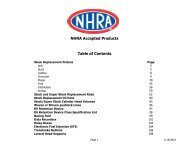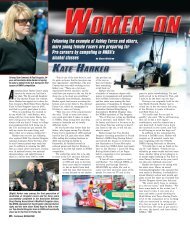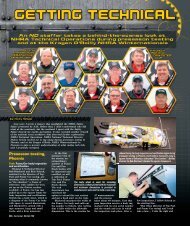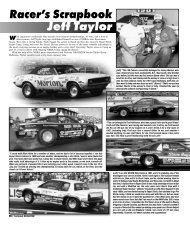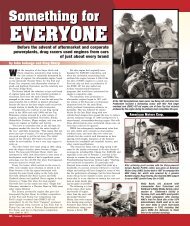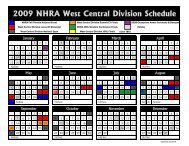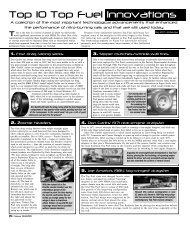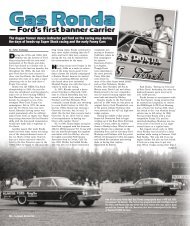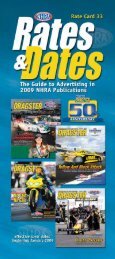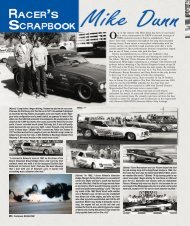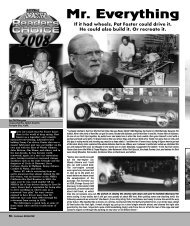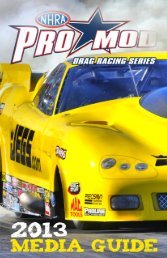2013 Exhibition Vehicle Rulebook Supplement.pdf - NHRA.com
2013 Exhibition Vehicle Rulebook Supplement.pdf - NHRA.com
2013 Exhibition Vehicle Rulebook Supplement.pdf - NHRA.com
You also want an ePaper? Increase the reach of your titles
YUMPU automatically turns print PDFs into web optimized ePapers that Google loves.
Stworzony dla tych, którzy cenià dobro pacjentaEwolucja diagnostyki SkyViewWzmacniacz obrazuSkyView jest systemem tomografiikomputerowej bazujàcej na detektorzewykorzystujàcym wzmacniacz obrazu,który zapewnia minimalnà dawk´promieniowania przy maksymalnymkontraÊcie i maksymalnej jakoÊci.Dawka, jakà otrzymuje pacjent, jestporównywalna z tà, którà pacjentotrzymuje w trakcie wykonywaniastandardowego pantomogramu.Lekarz zyskuje wi´c o wiele wi´cejinformacji diagnostycznych przypodobnej dawce promieniowaniadla pacjenta.PrecyzjaBezpoÊrednio po badaniu, SkyViewautomatycznie rozpoczyna rekonstrukcj´wolumetrycznà. Ta w pe∏ni automatycznaprocedura tworzy wiarygodnà wirtualnàreprezentacj´, wolnà od zniekszta∏ceƒi umo˝liwiajàcà prawid∏owe pomiary.Trzeci wymiar staje si´ tak naturalnyjak dwa pozosta∏e.Wysoka jakoÊçprzy niskiej emisji promieniowaniaTechnologia bazuje na trzech podstawowych elementach:tomografszpitalnyzdj´ciawszystkich z´bówSkyViewpantomogramz u˝yciem kliszypantomogramcyfrowydzienne t∏opromieniowania• Scyntylator, który przekszta∏ca promieniowaniena obraz widzialny• Koncentrator promieniowania, który wzmacniaobraz• Wysokiej jakoÊci sensor CCD sk∏adajàcy si´z pikseli o rozmiarze 7,4 µm
EXHIBITION FUEL MOTORCYCLEREQUIREMENTS & SPECIFICATIONSENGINE: 1ENGINEMust be of a type specifically designed and manufactured for motorcycle use. Maximumtwo engines, size unlimited, with any internal modifications permitted. Engines must beself-starting. Push, tow, or roller starts prohibited. An SFI Spec 46.1 engine restraintsystem mandatory.FUELNitromethane, alcohol, racing gasoline, gasohol, diesel, natural gas, or propanepermitted. Nitrous oxide permitted on naturally aspirated alcohol or gasoline-burningengines only.FUEL SYSTEMSteel-braided fuel lines mandatory. Dual cable positive-return throttle mandatory. Allmotorcycles must be equipped with a preloaded fuel shutoff connected by a lanyardbetween the rider and the trigger.NITROUS OXIDECommercially available nitrous oxide permitted. Bottle(s) must be stamped with a DOT-1800 pound rating and permanently mounted (hose clamps or tie wraps prohibited).Hoses from bottle(s) to solenoid must be high-pressure steel braided or <strong>NHRA</strong>acceptedhoses. Commercially available, thermostatically controlled, blanket-typewarmer accepted. Any other external heating of bottle(s) prohibited.SUPERCHARGERSupercharger must be equipped with a supercharger restraint system. Manifold burstpanel or rubber manifold connection mandatory on all supercharger installations.Nitrous oxide prohibited with any supercharger.TURBOCHARGERPermitted. Nitrous oxide permitted with turbocharger only when gasoline is used as afuel.DRIVETRAIN: 2CHAIN GUARDSMandatory on all motorcycles. Chain guard must be .060-inch steel or 1/8-inchaluminum and must be securely mounted in three places. Chain guard must cover thewidth and at least the top run of chain/belt, from centerline to centerline of thesprockets.CLUTCHAny type clutch permitted. Cast material prohibited in stress bearing areas. Clutch musthave a protective guard made of .060-inch steel or 1/8-inch aluminum that covers theunit 360 degrees.BRAKES & SUSPENSION: 3BRAKESHydraulic type, front and rear, mandatory. Steel-braided brake lines mandatory. Brakelines must be routed and mounted to ensure no contact with moving parts. Minimumsize: front, dual discs, 9-inch diameter by 1/8-inch thickness (single caliper permitted if7
11-inch diameter by 1/4-inch thickness; rear, 9-inch diameter by 1/4-inch thickness).Piston diameter must meet OEM minimums for brand of bike.CONTROLSHandlebar controls must be located in safe, workable position. Foot pegs and footcontrols must be located in safe, workable position and must be mounted in anaccepted manner. Rider must be able to shut off fuel without removing hands fromhandlebars. A secondary shut off device must be attached to rider in the event of apremature exit from motorcycle. This device must control the fuel valve. Dual cablepush-pull throttle assembly is mandatory. Lanyard for secondary shut off must be runthrough eyelet, allowing the lanyard to be pulled in any direction to force shut off.FRONT SUSPENSIONHydraulic-tube-type only; minimum tube diameter is 32mm. Minimum travel: 2 inches.Positive fork stops with a maximum turning arc of 14 degrees in either directionmandatory. Steering dampener mandatory.WHEELIE BARSWheelie bars mandatory. Length may not exceed 120". Wheels must be nonmetallic.FRAME: 4FRAMEMinimum tubing dimension: 1 inch by .058-inch; 4130 chromoly mandatory. All buttwelds must have visible reinforcement. All welding on chromoly must be by approvedheliarc (TIG) process.GROUND CLEARANCEMinimum of 2 inches with rider on bike and 10 psi in rear tire (includes exhaust andkickstand).TIRES & WHEELS: 5TIRESMust be specified for racing use by manufacturer. Any rear tire size permitted, as longas does not exceed rim width by more than two inches. Minimum front tire width: 3inches.WHEELSBead-lock rear wheel mandatory. Rear-wheel minimum: 15-inch minimum diameter;maximum: 18-inch diameter. Front-wheel minimum: 16-inch diameter; maximum:19-inchdiameter.BODY: 7FAIRINGS/FENDERSFront fairings must be solidly mounted to frame tubes. Rear fenders must cover width oftire extended past rear axle.SEATSeat, tail section, and rear fender may be incorporated as one unit and must include astep to prevent rider sliding backward.RIDER: 10CREDENTIALSValid <strong>NHRA</strong> <strong>Exhibition</strong> Fuel Motorcycle license mandatory. License applications will8
only be accepted from legitimate Fuel-type or Funny Bike-type vehicles, not street-typebikes. Prior to receiving an <strong>NHRA</strong> license, the following conditions must be met:Motorcycle must meet all established minimum requirements as outlined in this<strong>Exhibition</strong> Fuel Motorcycle section and current <strong>NHRA</strong> <strong>Rulebook</strong>.HELMETFull-face helmet and shield (goggles prohibited) meeting Snell M2005, M2010, SA2005,SA2010 or SFI 31.2A or 41.2A Specs mandatory.PROTECTIVE CLOTHINGFull all-leathers or SFI Spec 40.1/2 suit, leather boots that <strong>com</strong>pletely cover the anklewith toe-area reinforcement, and full-finger leather gloves mandatory. Gloves must beKevlar-lined or equipped with slide buttons. Suits may be one-piece design or joinedwith a zipper at the waist. Reinforcement and/or armor in the knee, elbow, shoulder, andknuckle areas required. Spine/back protector and ballistic chest protector mandatory onsupercharged, nitromethane burning, or nitrous motorcycles.LICENSING PROCEDURENew riders must notify <strong>NHRA</strong> of intention to obtain a license and all required forms andrules for the category. All new drivers will pay a license application fee with thesubmission of verification of physical examination. Rider must successfully <strong>com</strong>plete an<strong>NHRA</strong> physical and have a <strong>com</strong>pleted <strong>NHRA</strong> physical form signed by a licensedphysician in hand before any test runs are made. Physicals are required every twoyears.A minimum of six runs must be made, witnessed and documented by a minimum of twocurrently licensed <strong>NHRA</strong> <strong>Exhibition</strong> Fuel Motorcycle riders. Any currently licensed<strong>NHRA</strong> Pro Stock Motorcycle license holder may cross-grade to an <strong>Exhibition</strong> Top Fuellicense upon application to <strong>NHRA</strong> and <strong>com</strong>pletion of a checkout pass of a minimum of7.50 seconds (quarter-mile) and payment of the appropriate fees. The final runs mustbe quicker than 7.50 seconds or representative of the performance of the motorcycle.After <strong>com</strong>pletion of the test/license runs, applicant must <strong>com</strong>plete license applicationform in full and have it signed by the track manager or other authorized person.Applicant is responsible for sending the test form, medical (physical) form, time slips forall test runs documented on the application form, and the appropriate fees to: <strong>NHRA</strong>Technical Services Department 2035 Financial Way Glendora, CA 91741LICENSE RENEWALSRider must submit a <strong>com</strong>pleted physical form, signed by a licensed physician, and an<strong>NHRA</strong> <strong>Exhibition</strong> License application form along with appropriate fees. If license isexpired more than six months, rider must make three test runs, witnessed anddocumented on application form. A minimum of one run must be 7.50 seconds orquicker. If license is expired more than one year, the <strong>com</strong>plete application and testingprocess must be repeated (as if new rider). All <strong>Exhibition</strong> licenses are valid for two yearsfrom date of physical.NEWLicense application including <strong>NHRA</strong> membership: $308, Canada: $380RENEWALSFee is $208 including <strong>NHRA</strong> membership and must be renewed every two years.Canada: $2809
EXHIBITION V-8 MOTORCYCLEREQUIREMENTS & SPECIFICATIONSENGINE: 1ENGINEMust be single, internal <strong>com</strong>bustion, automobile-type engine with a maximum originaldisplacement of 400 cubic inches. Small-block engine only. Push, tow, or roller startsprohibited.EXHAUSTExhaust must be directed away from rider when in riding position.FUELGasoline, racing gasoline, gasohol, propane, natural gas, and ethanol permitted.Nitromethane prohibited.FUEL SYSTEMFuel-shutoff valve mandatory. Steel-braided line mandatory. All fuel tanks must besecurely mounted.NITROUS OXIDECommercially available nitrous oxide permitted. Bottle(s) must be stamped with a DOT-1800 pound rating and permanently mounted (hose clamps or tie wraps prohibited).Hoses from bottle(s) to solenoid must be high-pressure steel braided or <strong>NHRA</strong>acceptedhoses. Commercially available, thermostatically controlled, blanket-typewarmer accepted. Any other external heating of bottle(s) prohibited.SUPERCHARGER/TURBOCHARGERProhibited.DRIVETRAIN: 2CHAIN/DRIVE BELTPrimary chain or belt guards mandatory. Must be 1/8-inch steel or 1/4-inch aluminum,fully enclosed. Shaft drive must have protection for rider’s legs and body. Chain guardrequired. Must cover the width and at least the top run of chain or belt to centerline ofsprocket.CLUTCH/FLYWHEELClutch and flywheel meeting SFI Spec 1.1, 1.2, or 1.3 required.FLYWHEEL SHIELDFlywheel shield meeting SFI Spec 6.1, 6.2, 6.3 or shield made of 1/4-inch steel with360-degree coverage required.BRAKES & SUSPENSION: 3BRAKESOperational hydraulic or mechanical disc brakes front and rear mandatory. Disc brakeson front must be minimum: Dual rotors, 9-inch diameter by 1/8-inch thickness; singlerotor, 11-inch diameter x 3/16-inch thickness. Rear brakes must be a minimum of 10-inch diameter x 3/16-inch thickness or <strong>NHRA</strong>-accepted system. Steel-braided linesrequired.CONTROLSHandlebar controls must be located in safe, workable position. Foot pegs and footcontrols must be located in safe, workable position and must be mounted in an10
current <strong>NHRA</strong> <strong>Rulebook</strong>. Rider must successfully <strong>com</strong>plete an <strong>NHRA</strong> physical and havea <strong>com</strong>pleted <strong>NHRA</strong> physical form signed by a licensed physician in hand before any testruns may be made. New physical required every two years. A minimum of six runsmust be <strong>com</strong>pleted, witnessed, and documented by a license <strong>com</strong>mittee accepted by<strong>NHRA</strong>. All runs must be made at <strong>NHRA</strong> member tracks. Final runs must be quicker than9.99 seconds (quarter-mile) or representative of the performance of the bike. Upon<strong>com</strong>pletion of test runs, applicant must forward the <strong>com</strong>pleted license forms with allapplicable signatures, original physical form, and time slips along with full fees to:<strong>NHRA</strong> Technical Services Department 2035 Financial Way Glendora, CA 91741. Riderslicensed under this program are restricted to single runs only. Match races or side-byside<strong>com</strong>petition with any other vehicle is prohibited.INITIAL INSPECTIONContact <strong>NHRA</strong> Tech Department for initial inspection procedures.NEWLicense application including <strong>NHRA</strong> membership: $308, Canada: $380RENEWALSFee is $208 including <strong>NHRA</strong> membership and must be renewed every two years.Canada: $280LICENSE SUSPENSIONAny rider found in violation of <strong>NHRA</strong> rules and/or regulations may be subject topenalties as determined appropriate in the sole and absolute discretion of the <strong>NHRA</strong>.PERFORMANCE LIMITSV-8 motorcycles with engine mounted in a longitudinal method (crankshaft at rightangles to rear wheel) may utilize a limit of 205.99 mph in the quarter-mile. V-8motorcycles with the engine mounted with the crankshaft parallel to the wheelbase ofthe motorcycle are restricted to 150.99 mph in the quarter-mile. All accidents, incidents,problems, or failures (Whether they occur at <strong>NHRA</strong> member tracks or facilities or not.)MUST BE REPORTED TO THE <strong>NHRA</strong> TECHNICAL SERVICES DEPARTMENTIMMEDIATELY (within 48 hours). Failure to report such events or careless operation ofany motorcycle in this program may cause suspension of license or fines. Anyprocedure, requirement, or specification described herein may be amended by the<strong>NHRA</strong> at any time.12
BRAKES & SUSPENSION: 3BRAKESCaliper-type disc brakes required on all four wheels. Two separate hydraulic systemsrequired; may be front/rear or double system.SUSPENSIONFunctional front and rear suspension optional. Rear shocks, if used, must be installed insuch a manner as to retain integrity of suspension in case of failure.FRAME: 4FRAME: 4GROUND CLEARANCEMinimum 3 inches from front of car to 12 inches behind centerline of front axle, 2 inchesfor remainder of car.PARACHUTESDual parachutes mandatory. Separate shroud-line mounting points required with ½-inchsleeved grade 8 bolts. Primary parachute must be on a control system that will shut offengine when parachute is released. Secondary parachute must be used as anindependent backup system with engine shutdown capabilities (secondary fuel shutoffbypass valve on main fuel line to work with secondary parachute). Must have at leasttwo ways to positively shut off jet engine. Parachute mount must be substantially boltedand/or welded in place. Minimum parachute connection spool diameter: 1 inch. FunnyCars required to have a minimum 10-foot bridle cord to attach pilot parachute. Chutesand shroud lines must be mounted in such a position as to be protected from tailpipeheat. All unpacked shroud lines must be covered with 1/16-inch leather or <strong>NHRA</strong>acceptedmaterial (silver tape prohibited). Steel, aluminum, or carbon-fiber parachutetubes only. Parachute packs prohibited.ROLL CAGEDragster chassis must meet SFI Spec 2.1; Funny Car chassis must meet SFI Spec2.2B, 2.1, or 10.1E. Plating of chassis prohibited; painting permitted. Chassis must berecertified every two years by <strong>NHRA</strong> and have serialized sticker affixed to frame beforeparticipation. Absolutely no motorcycles or three-wheeled vehicles will be considered forthis program. Roll-cage padding meeting SFI Spec 45.1 mandatory anywhere driver’shelmet may <strong>com</strong>e in contact with roll-cage <strong>com</strong>ponents.WEIGHTMinimum 1,250 pounds; maximum 3,200 pounds. All weights include driver and residualfuel at <strong>com</strong>pletion of run.WHEELBASE, DRAGSTERMinimum 180 inches; maximum 300 inches.WHEELBASE, FUNNY CARMinimum 125 inches; maximum 135 inches.TIRES & WHEELS: 5TIRES & WHEELS: 5TIRESDrive tires restricted to Goodyear NASCAR Radials D4006 and D4224 or GoodyearBias Ply 2270 and D2291. Tires are to meet size requirements when installed and readyto run at manufacturer’s re<strong>com</strong>mended operating pressures. Minimum front-wheeldiameter on jet Funny Cars, 14 inches.14
ARM RESTRAINTSMandatory.CREDENTIALSValid <strong>NHRA</strong> jet license mandatory. Applicant must be minimum 18 years of age.Licensing is on an individual basis through the <strong>NHRA</strong> Technical Services Department.Contact <strong>NHRA</strong> Technical Services Department for more information.DRIVER LOCATIONDriver must be sealed off from intake by firewall of at least shoulder height. If locatednext to <strong>com</strong>pressor section, driver must be totally isolated from <strong>com</strong>pressor by 3/8-inch7075-T6 aluminum shield. J-85 Funny Cars must be additionally equipped with aminimum 360-degree .050-inch stainless steel shield en<strong>com</strong>passing <strong>com</strong>bustion and<strong>com</strong>bustion can. If driver is located near hot section, insulation must be used to protectdriver from engine heat.DRIVER RESTRAINT SYSTEMA quick-release, 3-inch minimum width driver restraint system, with a 2-inch crotchstrap, meeting SFI Spec 16.1 or a 2-inch minimum width driver restraint system, with a2-inch crotch strap meeting SFI Spec 16.5 is mandatory in all cars. A 3-inch SFI Spec16.5 driver restraint system is also acceptable wherever an SFI Spec 16.1 is mandatoryor permitted. Driver restraint system must be clearly labeled as meeting SFI Spec 16.1or SFI Spec 16.5 and be dated by manufacturer. SFI 16.1 or 16.5 3-inch wide shoulderharness straps folded over and sewn to be 2-inches wide by the original manufacturer inorder to fit into head and neck restraint lips/channels are acceptable; SFI 16.1 2-inchwide shoulder harness straps are not permitted. Restraint system must be updated attwo-year intervals from date of manufacture.Effective 1/1/2014: Minimum 6-points of attachment mandatory and installed accordingto the manufacturer’s instruction.HEAD AND NECK RESTRAINT DEVICE/SYSTEMAt all times that the driver is in the race vehicle, from the ready line until the vehicle ison the return road, driver must properly utilize an SFI-approved head and neck restraintdevice/system, including connecting the helmet as required for full functionality of thedevice. The device/system must meet SFI Spec 38.1 and must display a valid SFI label.The head and neck restraint device/system, when connected, must conform to themanufacturer’s mounting instructions, and it must be configured, maintained, and usedin accordance with the manufacturer’s instructions.HELMETFor all cars, a full-face SA2005, SA2010 or SFI 31.2A helmet and shield mandatory(goggles prohibited).PROTECTIVE CLOTHINGDrivers of dragsters must wear a suit meeting SFI Spec 3.2A/15 with SFI 3.3/15 glovesand SFI 3.3/15 boots. Drivers of Funny Cars must wear a suit meeting SFI Spec3.2A/20 with SFI 3.3/20 gloves and SFI 3.3/20 boots. Head sock 3.3 mandatory. A headsock is not mandatory when helmet is manufactured with a skirt and labeled as meetingSFI Spec. 3.3.LICENSED DRIVER, NEW VEHICLEAny currently licensed <strong>NHRA</strong> exhibition-jet driver may cross-grade to any otherexhibition-jet vehicle category. Must be witnessed by two currently licensed jet driverswith a minimum of three years’ jet-driving experience each. Runs may be made at open16
track session. Runs may be made in a single day.LICENSE, NEW DRIVERNew driver must notify <strong>NHRA</strong> of intention to obtain a license and receive all requiredforms and rules for the category. Applicant must be minimum 18 years of age. All newdrivers will pay a license application fee with the submission of a physical-exam form.Proof of car must be submitted and inspection must be performed prior to <strong>NHRA</strong> issuinga permit, which will include <strong>NHRA</strong> membership and insurance, to begin initial licensingruns. New driver or driver cross grading from Funny Car to dragsters, etc. will be givena cockpit-orientation (blindfold) test. New driver must make a minimum of 12 test runsover a two-day (minimum) period. All runs must be made at a closed session. Blindfoldtest and test runs must be witnessed by two currently licensed jet exhibition drivers withat least three years’ experience, a track official, and an <strong>NHRA</strong>-designated person. Testruns are typically divided into three sessions, as follows:Session 1: Three half passes, one moderate pass.Session 2: Four moderate passes.Session 3: One moderate pass, three full passes.Driver cross-grading from one jet exhibition category to another must <strong>com</strong>plete ablindfold test and minimum three full test runs in front of standard witnesses. (A driverwith an <strong>NHRA</strong> <strong>com</strong>petition license in any wheel-driven category may not cross-grade toa jet exhibition license, regardless of experience.) In all categories, <strong>com</strong>petitionlicense will be granted or denied in <strong>NHRA</strong>’s discretion.EXPIRED LICENSEIf license is expired one year or more, applicant must meet all new-driver requirements.FEESNew: License application including <strong>NHRA</strong> membership: $308, Canada: $380Renewals: Fee is $208 including <strong>NHRA</strong> membership and must be renewed every twoyears. Canada: $280CHASSIS AND VEHICLE INSPECTION: $400; valid two years; Change of ownershipof the vehicle voids the current chassis and vehicle inspection; a recertification isrequired when ownership of the vehicle changes.Cross-grade: each category, $100.PERFORMANCE LIMITSJet dragsters, 320.99 mph; jet Funny Cars, 305.99 mphIf a driver exceeds these limits, the following fines apply:FIRST OFFENSE: 1-10 mph: $500 fine. 11+ mph: $2,000 fine.SECOND OFFENSE: 1-10 mph: $1,500 fine/six-month suspension. 11+ mph: $5,000fine/six-month suspension.THIRD OFFENSE: 1+ mph: $5,000 fine/indefinite suspension.All accidents, engine problems other than routine maintenance, and/or repeatedproblems or failures of the same nature (Whether they occur at <strong>NHRA</strong> member tracks orfacilities or not.) MUST BE REPORTED TO THE <strong>NHRA</strong> TECHNICAL SERVICESDEPARTMENT IMMEDIATELY (within 48 hours). Failure to report such incidents,careless operation of vehicle, and/or hot-end failure is in violation of <strong>NHRA</strong> rules andregulations and may result in penalties ranging from formal warning to immediate and17
indefinite suspension of exhibition privileges. In some instances, a monetary fine maybe imposed. See current <strong>NHRA</strong> <strong>Rulebook</strong> for appeal procedures. Any procedure orrequirement described herein may be waived or amended by <strong>NHRA</strong>, if <strong>NHRA</strong> in its solejudgment determines that such waiver or amendment is appropriate.18
JET TRUCKTHIS SUPPLEMENT ACCOMMODATES SPECIALIZED JET-POWERED TRUCKSAND IS A SUPPLEMENT TO THE CURRENT <strong>NHRA</strong> EXHIBITION JET PROGRAM.PARTICIPANTS IN THIS PROGRAM MUST CONSULT JET-POWERED DRAGSTER& FUNNY CAR FOR ANY ADDITIONAL APPLICABLE INFORMATION.COMPETITIONJet trucks are considered exhibition vehicles and are restricted to single runs only. Sideby-sideruns are prohibited. Jet trucks may not <strong>com</strong>pete for prize money. SeePERFORMANCE LIMITS.REQUIREMENTS & SPECIFICATIONSENGINE: 1AFTERBURNER-TAILPIPEFor butts, seams must be on bottom; overlap seam placement will be at the discretion ofthe technical inspector. Dump valve on afterburner manifold mandatory; valve to beactuated with primary chute lever (to prevent shutoff smoke).AIR INTAKEAll air intakes must be securely screened (1/8-inch minimum, 1/4-inch maximum orequivalent). Such screening must be securely attached to the engine.CATCH CANFuel-overflow catch tanks of sufficient capacity to ac<strong>com</strong>modate excess fuel onshutdown and adequate tank venting (approximately 1 quart) required on all vehicles.Use of hose clamps and/or tie wraps for mounting prohibited.CONTROL CABLESManual afterburner control valve cable, minimum 1/4-inch. Fuel control cable must beminimum 3/16-inch. Must have secondary shutoff on main fuel line. Emergency shutoffon afterburner mandatory. See PARACHUTES for additional details.ENGINE(S)Engine(s) attitude must have down thrust; minimum -1 degree angle required. Frontengine mounts must be expandable (TRUNION) type, allowing at least 3/16-inch, 360-degree lateral expansion. Permitted engines are J-34, J-46, J-60 (JT-12), J85-5 (CJ-610), J-79, Rolls Royce Viper 522. Maximum 3 engines allowed, except J-79, restrictedto one engine only.FUEL FILTERA suitable fuel filter must be installed on the inlet side of the hot streak valve.FUELApproved jet-type fuel only (Jet A, Jet A-1, kerosene, diesel). Only diesel fuel additivespermitted. Separate water and methanol injection systems allowed. Racing gasolinepermitted for starting purposes only.FUEL TANKMust be securely mounted to frame with appropriate baffling (welded or equivalent). Ifpressurized, tank must be round. Mechanism to release fuel-tank pressure mandatory.If electrical device, switch must be “normally open” type.INSTRUMENTSAll instruments, gauges, and metering devices must be fully functional. The followinginstruments must be visible from the cockpit of each vehicle: tachometer (percent ofrpm); exhaust-gas-temperature gauge (EGT); oil-pressure gauge/light (taken from19
pump-outlet housing).BRAKES & SUSPENSION: 3BRAKESCaliper-type disc brakes required on all four wheels. Two separate hydraulic systemsrequired; may be front/rear or double system. All brake systems must be steel-ventedrotor type.SUSPENSIONFunctional suspension optional. Front suspension applications must be minimum fourbarradius rod type. Rear upper-shock eyes must be pinned or otherwise secured. Rearshocks must be installed in such a manner as to retain integrity of suspension in case offailure.FRAME: 4GROUND CLEARANCEMinimum 3 inches from front of vehicle to 12 inches behind front axle centerline, whichmust be maintained at all times.BUMPERS<strong>Vehicle</strong> must be equipped with a satisfactory bumper/nerf bar device so designed toprevent front tire from be<strong>com</strong>ing first point of impact with guard wall at a 45-degreeangle.PARACHUTESMinimum of two (2) braking parachutes required. Primary parachute must be on acontrol system that will shut off engine when parachute is released. Secondaryparachute must be used as an independent backup system with engine-shutdowncapabilities (secondary fuel-shutoff bypass valve on main fuel line to work withsecondary parachute). Must have at least two ways to positively shut off jet engine.Parachute mounts must be substantially bolted and/or welded in place; each parachutemust utilize a separate mounting point. Minimum chute connection spool diameter: 1.50inches. Parachutes and shroud lines must be mounted in such a position as to offerprotection from tailpipe heat. Parachute attachment lines must be covered with 1/16-inch leather or <strong>NHRA</strong>-accepted material (silver tape prohibited). Steel, aluminum, orcarbon-fiber parachute tubes only. Parachute packs prohibited.ROLL CAGECage structure must be designed to protect driver from any angle, 360 degrees.Material used in construction must be a minimum of 1 1/2-inch x .095-inch chromolytubing when a funny car insert is also installed; otherwise 1 5/8-inch x .095-inchchromoly tubing welded to frame. All vehicles must successfully pass <strong>NHRA</strong> inspectionevery two (2) years and have a serialized chassis sticker affixed to frame beforeparticipation. INITIAL CERTIFICATION OF VEHICLES MUST BE DONE AT AN <strong>NHRA</strong>NATIONAL EVENT ONLY. <strong>Vehicle</strong> may be re-inspected at any <strong>NHRA</strong> divisional event,National Open, national event, or by individual appointment with <strong>NHRA</strong>. Priorarrangements must be made with the national technical director, or division techdirector. Drivers are instructed to bring all required safety apparel and have vehicle inready-to-run condition. Change of ownership of the vehicle voids the current chassisand vehicle inspection; a recertification is required when ownership of the vehiclechanges.WEIGHT20
Maximum 7,500 pounds. All weights excluding driver and fuel. Certified weightcertificate required.WHEELBASEMinimum 120 inches; maximum 300 inches.TIRES & WHEELS: 5TIRESTires specifically built or modified for racing only must be used front and rear. Maximumheight of any tire is 45 inches. RECAPS NOT PERMITTED. Visible cord damage insidewall requires tire change. All casings must be of new manufacture.WHEELSFull floating hubs required on rear wheels.INTERIOR: 6SHEET METALAll sheet metal within driver <strong>com</strong>partment must be aluminum or steel; magnesiumprohibited.BODY: 7BODYMust be an original or replica of a <strong>com</strong>mercial truck or emergency vehicle to qualify forthis program.SUPPORT GROUP: 9FIRE EXTINGUISHING SYSTEMMust be equipped with an onboard fire extinguishing system of at least 10-poundcapacity installed to provide protection for the driver. Extinguishing agents must be<strong>NHRA</strong>-accepted.FIREWORKSThe release of onboard fireworks prohibited.SHUT OFF DEVICES (Effective 3/1/<strong>2013</strong>)Moving of the throttle to the maximum position arms an automatic shutoff deviceinstalled such that release of a driver actuated momentary switch will shut off all fuel tothe engine (including the afterburner), and deploy either the primary chute or theemergency chute. The system may be electrically and/or pneumatically operated. In theabsence of either electrical power or pneumatic pressure to the system, the system willprevent the engine from running, and loss of either electric power or pneumaticpressure to the system during the run will also shut off all fuel to the engine (includingthe afterburner).Additionally, a timer, set at 0.2 seconds above the normal or expected elapsed time ofthe participating car, and armed by going to maximum throttle, shall be triggered eitherby the activation of the hot streak, and/or release of brake pedal/handle. Onceactivated, and timed out, the system shall shut off all fuel to the engine (including theafterburner), and deploy either the primary chute or the emergency chute.Absolutely no delays, overrides, or bypasses of any description are permitted in any ofthe shutdown devices/systems.21
RIVER: 10DRIVER: 10CREDENTIALSValid <strong>NHRA</strong> jet truck license mandatory. Licensing is on an individual basis through the<strong>NHRA</strong> Technical Services Department. Contact <strong>NHRA</strong> for more information.DRIVER LOCATIONDriver must be located in front of engine and sealed off from intake and fuel system by afirewall and/or windows that extend and seal to the top of the driver's <strong>com</strong>partment.One seat for driver permitted. Secondary seat not permitted. Passengers not permittedat any time. Must have at least two methods to exit from vehicle (door, roof hatch, orremovable windshield) with release operable from inside and outside of the vehicle.DRIVER RESTRAINT SYSTEMA quick-release, 3-inch minimum width driver restraint system, with a 2-inch crotchstrap, meeting SFI Spec 16.1 or a 2-inch minimum width driver restraint system, with a2-inch crotch strap meeting SFI Spec 16.5 is mandatory in all cars. A 3-inch SFI Spec16.5 driver restraint system is also acceptable wherever an SFI Spec 16.1 is mandatoryor permitted. Driver restraint system must be clearly labeled as meeting SFI Spec 16.1or SFI Spec 16.5 and be dated by manufacturer. SFI 16.1 or 16.5 3-inch wide shoulderharness straps folded over and sewn to be 2-inches wide by the original manufacturer inorder to fit into head and neck restraint lips/channels are acceptable; SFI 16.1 2-inchwide shoulder harness straps are not permitted. Restraint system must be updated attwo-year intervals from date of manufacture.Effective 1/1/2014: Minimum 6-points of attachment mandatory and installed accordingto the manufacturer’s instruction.HEAD AND NECK RESTRAINT DEVICE/SYSTEMAt all times that the driver is in the race vehicle, from the ready line until the vehicle ison the return road, driver must properly utilize an SFI-approved head and neck restraintdevice/system, including connecting the helmet as required for full functionality of thedevice. The device/system must meet SFI Spec 38.1 and must display a valid SFI label.The head and neck restraint device/system, when connected, must conform to themanufacturer’s mounting instructions, and it must be configured, maintained, and usedin accordance with the manufacturer’s instructions.HELMETFull face helmet and shield (goggles prohibited) meeting Snell SA2005,SA2010 or SFI31.2A Spec mandatory. See General Regulations.PROTECTIVE CLOTHINGDrivers must wear a suit meeting SFI Spec 3.2A/15. All drivers must wear SFI 3.3/15gloves and SFI 3.3/15 boots and SFI Spec 3.3 head sock or skirted helmet.LICENSING PROCEDURESLicenses will be issued restricting driver/vehicle as a unit to the vehicle in whichlicensing was conducted.LICENSE, NEW DRIVERNew driver must notify <strong>NHRA</strong> of intention to obtain a license and all required forms andrules for the category. All new drivers will pay a license application fee with the22
submission of verification of physical examination. Proof of car and inspection arerequired prior to <strong>NHRA</strong> issuing a permit, which will include <strong>NHRA</strong> membership andinsurance, to begin initial licensing runs. New driver, or driver cross-grading from FunnyCar to dragster, etc., will be given a cockpit-orientation (blindfold) test. New driver mustmake a minimum of 12 test runs over a two-day (minimum) period. Blindfold test andtwo currently licensed jet-exhibition drivers with at least three years’ experience, a trackofficial, and an <strong>NHRA</strong>-designated person must witness test runs. Test runs are typicallydivided into three sessions, as follows:Session one: three half passes and one moderate run.Session two: four moderate runs.Session three: one moderate and three full run’s with afterburner.Full runs must be representative of vehicle’s performance and at least 7.00 seconds orquicker in the quarter-mile.All sessions must be made at closed sessions. A minimum of 12 runs must be madeover a period of two days (need not run consecutively). All runs must be <strong>com</strong>pleted overa period of 90 days or less. Upon <strong>com</strong>pletion of license runs, applicant must submit<strong>com</strong>pleted, signed application and time slips for all runs to <strong>NHRA</strong> Technical ServicesDepartment.CROSS-GRADE REQUIREMENTSAny currently licensed jet vehicle driver may cross grade to jet truck by <strong>com</strong>pleting thefollowing:1. Applicant must receive authorization from <strong>NHRA</strong> Technical Services Department.2. A cockpit-orientation test.3. A minimum of three runs in front of standard witnesses.LICENSED DRIVER, NEW VEHICLEA currently licensed jet truck driver may drive any other jet truck by making a minimumof one moderate orientation run and receiving authorization from <strong>NHRA</strong> TechnicalServices Department prior to making any full runs.FEESNew: License application including <strong>NHRA</strong> membership: $308, Canada: $380Renewals: Fee is $208 including <strong>NHRA</strong> membership and must be renewed every twoyears. Canada: $280CHASSIS AND VEHICLE INSPECTION: $400; valid two years; Change of ownershipof the vehicle voids the current chassis and vehicle inspection; a recertification isrequired when ownership of the vehicle changes.Cross-grade: each category, $100.PERFORMANCE LIMITSMaximum 220.99 mph. Limit will be STRICTLY ENFORCED. Exceeding theperformance limit will result in the following:FIRST OFFENSE: 1-10 mph: $500 fine. 11+ mph: $2,000 fine.SECOND OFFENSE: 1-10 mph: $1,500 fine/six-month suspension. 11+ mph: $5,000fine/six-month suspension.23
THIRD OFFENSE: 1+ mph: $5,000 fine/indefinite suspension.All accidents, engine problems other than routine maintenance, and/or repeatedproblems or failures of the same nature (Whether they occur at <strong>NHRA</strong> member tracks orfacilities or not.) MUST BE REPORTED TO THE <strong>NHRA</strong> TECHNICAL SERVICESDEPARTMENT IMMEDIATELY (within 48 hours). Failure to report such incidents,careless operation of vehicle, and/ or hot-end failure is in violation of <strong>NHRA</strong> rules andregulations and may result in penalties ranging from formal warning to immediate andindefinite suspension of exhibition privileges. In some instances, a monetary fine maybe imposed. See current <strong>NHRA</strong> <strong>Rulebook</strong> for appeal procedures. Any procedure orrequirement described herein may be waived or amended by <strong>NHRA</strong>, if <strong>NHRA</strong> in its solejudgment determines that such waiver or amendment is appropriate.24
NITRO HARLEY DAVIDSONDESIGNATIONTFMC, preceded by bike number. Reserved for fuel-burning Harley-Davidsonmotorcycles, built specifically for all-out drag racing <strong>com</strong>petition. Refer to the current<strong>NHRA</strong> <strong>Rulebook</strong> or rule amendments for vehicle/rider requirements, specifications, andgeneral regulations.REQUIREMENTS & SPECIFICATIONSENGINE: 1ENGINEMust keep design feature of Harley-Davidson engines (pushrod, 45-degree to 90-degree V-Twin). Carbureted, fuel-injected, or supercharged single or double engineswith a maximum displacement of 200 cid. An SFI Spec 46.1 engine restraint systemmandatory. Must have "belly pan" scatter shield under engine.CYLINDER HEADAftermarket pushrod heads (including 4-valve) permitted.FUELAll fuels other than nitromethane and methanol prohibited.SUPERCHARGERSuperchargers must have rubber manifold connections or some form of “sneeze” valve.Supercharger blankets mandatory. See General Regulations.VENT TUBESCrankcase and all tanks containing fluids must have vent tubes routed to catch can orhave a non-spill breather system on motorcycle. See General Regulations.DRIVETRAIN: 2CHAIN GUARDMandatory on all motorcycles. Chain guard must be .060-inch steel or 1/8-inchaluminum and must be securely mounted in three places. Chain guard must cover thewidth and at least the top run of the chain, from centerline to centerline of sprockets.CLUTCHAny type dry friction clutch, including multi-stage setup, permitted. Clutch engagementmust be by centrifugal force only and must exhibit reliable disengagement at idle speed.Clutch must have a protective guard made of .060-inch steel or 1/8-inch aluminum thatcovers the unit 360 degrees.TRANSMISSIONAny transmission or high-gear-only system may be used.BRAKES & SUSPENSION: 3BRAKESHydraulic type, front and rear, mandatory. Steel-braided brake lines mandatory. Brakelines must be routed and mounted to ensure no contact with moving parts. Two-rotorfront brakes permitted. Minimum size: 11-inch diameter, 3/16-inch thickness for singlerotor; 9-inch diameter, 1/8-inch thick with dual rotor brakes.CONTROLSHandlebar controls must be located in safe, workable position. Foot pegs and footcontrols must be located in safe, workable position and must be mounted in an25
accepted manner. Rider must be able to shut off fuel without removing hands fromhandlebars. A secondary shut off device must be attached to rider in the event of apremature exit from motorcycle. This device must control the fuel valve. Dual cablepush-pull throttle assembly is mandatory. Lanyard for secondary shut off must be runthrough eyelet, allowing the lanyard to be pulled in any direction to force shut off.SUSPENSIONFront suspension minimum size: 32mm. Minimum travel: 2 inches. Steering dampenermandatory. Rear suspension permitted. Fork stops required; must limit the turning arc to28 degrees.WHEELIE BARSWheelie bars mandatory. Minimum length, from centerline of rear axle to centerline ofwheelie-bar axle: 84 inches; maximum, 120 inches. Must be securely cross-braced.FRAME: 4FRAMEAftermarket frames permitted. All frame <strong>com</strong>ponents, except braces, brackets, andgussets, must be manufactured from minimum 1 1/8-inch x .065-inch 4130 chromolytubing. All welding must be done by approved heliarc process. Rake angle must be atleast 40 degrees. All butt welds must have visible reinforcement. Plating of frameprohibited. Painting permitted. Frames constructed before 1999 and approved for<strong>com</strong>petition may use 1-inch x .058-inch tubing.GROUND CLEARANCEMinimum of 2 inches with rider of bike with 10psi in rear tire (includes exhaust andkickstand).WHEELBASEMinimum 85 inches.TIRES & WHEELS: 5TIRESMust be specified for racing use by manufacturer. Any rear-tire size permitted.WHEELSRear-wheel minimum: 15-inch diameter; maximum, 18-inch diameter. Front-wheelminimum: 16-inch diameter; maximum, 19-inch diameter.SEAT: 6SEATSeat, tail section, and rear fender may be incorporated as one unit and must include astep to prevent rider sliding backward.BODY: 7BODYNo body parts are necessary, except rear fender that must cover the width of the tireand extend past the rear axle.FAIRINGSPermitted. Must be solidly mounted to frame tubes.ELECTRICAL: 826
CHARGING SYSTEMPermitted.CONTROL SWITCHESMust be mounted and constructed in an accepted manner. Must have an emergencyfuel and ignition kill switch.IGNITIONAny ignition system permitted.STARTING SYSTEMMust be electric external starter. Battery top covers required. No rollers. No push starts.Jack stands mandatory for starting.LIGHTSAccepted.SUPPORT GROUP: 9COMPUTERS/DATA RECORDERSCan be used for information gathering only. Throttle operation, shifting, clutch actuation,etc. are to be solely under the control of the rider. See General Regulations.RIDER: 10CREDENTIALSValid <strong>NHRA</strong> <strong>com</strong>petition license mandatory. See Section 2 - <strong>Exhibition</strong> Fuel Motorcyclefor licensing procedure. See General Regulations.HELMETFull-face helmet and shield (goggles prohibited) meeting Snell M2005, M2010,SA2005,SA2010 or SFI 31.2A or 41.2A Specs mandatory.PROTECTIVE CLOTHINGFull all-leathers or SFI Spec 40.1/2 suit, leather boots that <strong>com</strong>pletely cover the anklewith toe-area reinforcement, and full-finger leather gloves are mandatory. Gloves mustbe Kevlar-lined or equipped with slide buttons and have knuckle armor and palmreinforcement. Suits may be one-piece design or joined with a zipper at the waist.Reinforcement and/or armor in the knee, elbow, shoulder, and knuckle areas required.Spine/back protector and ballistic chest protector mandatory.27
SPECIAL FUELNotice: Special Fuel is not an <strong>NHRA</strong> category or eliminator. It is not part of the <strong>NHRA</strong><strong>Exhibition</strong> program. It has been established primarily for the purpose of licensing driversof vehicles that use nitromethane as a fuel and run elapsed times slower than 5.99seconds in the quarter-mile.These rules are designed as minimum safety rules & regulations for nitromethanevehicles running 6.00 (3.66 eighth-mile) to 7.99 (4.99) seconds. Individual groups ofvehicle owners and <strong>NHRA</strong> member tracks are allowed to implement specific andadditional restrictions as to body style, chassis type, and specific E.T. range within therules as written. Refer to the current <strong>NHRA</strong> <strong>Rulebook</strong> or rule amendments forvehicle/driver requirements, specifications, and general regulations.REQUIREMENTS & SPECIFICATIONSENGINE: 1ENGINE(S)Any internal-<strong>com</strong>bustion reciprocating 90-degree automotive engine(s) permitted.EXHAUSTMust be directed away from driver, track, and vehicle.FUELNitromethane mandatory.FUEL SYSTEMMetal fuel tank or fuel cell required. Fuel lines must be located outside driver’s<strong>com</strong>partment. Fuel tanks must be enclosed in a round tube frame, a minimum 1 1/4-inch O.D. x .065-inch chromoly tubing if mounted outside of frame.LIQUID OVERFLOWCatch can mandatory if coolant is used.NITROUS OXIDEProhibited.SUPERCHARGERMaximum size 14-71 Roots type only. SFI Spec 14.3 supercharger restraint systemmandatory. Aluminum studs required. Burst panel meeting SFI Spec 23.1 required. SFISpec 14.1 restraint permitted with Roots-type 6-71 supercharger and nitromethane.Turbochargers, screw-, and centrifugal-type superchargers prohibited.VALVE COVERSCast or fabricated metal valve covers, using all attachment bolt holes, mandatory.DRIVETRAIN: 2CLUTCH, FLYWHEEL, FLYWHEEL SHIELDFlywheel and clutch meeting SFI Spec 1.3 or 1.4 mandatory. Flywheel shield meetingSFI Spec 6.2 or 6.3 mandatory. Clutch management system prohibited. Release ofclutch must be the result of a manual operation by driver's foot. See GeneralRegulations.DRIVELINE COVEREach end of driveshaft must have a 360-degree cover of minimum 1/16-inch steel or1/8-inch aluminum. Rear cover must surround coupler. Front cover must surround thedriveshaft from the back of the reverser to the end of the splicer sleeve in the area of28
the driver’s legs. All covers must be securely mounted to frame, a suitable crossmember, or the third member.REAR ENDAftermarket full-floating or live axle assembly mandatory on all vehicles running 7.49(4.85) seconds or quicker.TRANSMISSIONIn-out box permitted with reverser. Aftermarket planetary type with reverser permitted. Aone-piece ballistic shield covering all units mandatory. Shield must meet SFI Spec 4.1.OEM or OEM modified transmission prohibited. See General Regulations.BRAKES: 3BRAKESMinimum two rear wheel (one caliper per wheel) hydraulic brakes mandatory.STEERINGIf removable steering wheel is used, <strong>com</strong>mercially available quick-disconnect steeringwheel adapter meeting SFI Spec 42.1 mandatory.WHEELIE BARSPermitted. Wheels must be nonmetallic.FRAME: 4PARACHUTESDual parachutes mandatory on vehicles running 7.49 and quicker or over 190 mph.Parachute pack and unpacked shroud lines must be protected with fire-resistantmaterial from mounting point to the pack.ROLL CAGE<strong>Vehicle</strong>s running 7.49 (4.49) e.t. and quicker must have a roll cage meeting SFIspecifications 25.1E, 25.2, 10.5, 10.3, 10.2, 10.1E, 2.1, 2.2B, 2.3N, 2.5B, or 2.4B.<strong>Vehicle</strong>s running 7.50 e.t. or slower must meet applicable SFI Spec requirements.Plating of any chassis manufactured after 1/1/99 prohibited. Chassis must be inspectedevery three years and have an <strong>NHRA</strong> chassis sticker affixed to the cage.SUSPENSIONFront suspension optional. Rigid rear suspension permitted on dragsters, altereds andFunny Cars only.WHEELBASEMinimum 100 inches, maximum 125 inches, bodied cars. Dragster maximum 300inches. Measured on long side.INTERIOR: 6SEATSeat must be metal or fiberglass. Magnesium prohibited. A flame retardant materialcovered seat is mandatory.BODY: 7AIRFOILS, WINGSPermitted. Nonadjustable during run.BODYCenter-steer dragster, altered, roadster, or Funny Car-type body permitted. Pro Mod-or29
Pro Stock-type vehicles prohibited.FIREWALLMust be equipped with a minimum .032-inch aluminum or .024-inch steel firewall. Must<strong>com</strong>pletely seal top to bottom and side to side, driver’s <strong>com</strong>partment from engine<strong>com</strong>partment. Use of magnesium is prohibited.ELECTRICAL: 8IGNITIONMust have positive on/off switch, capable of de-energizing the entire ignition system, ingood working order. Located within easy reach of the driver.MASTER CUTOFF SWITCH (for vehicles with battery)Mandatory. Must cut off all electrical functions of vehicle. See General Regulations.SUPPORT GROUP: 9FIRE EXTINGUISHERMinimum 20 pounds. <strong>NHRA</strong>-accepted fire extinguishing system mandatory on all FunnyCars and enclosed body altereds. Minimum 5 pounds for front-engine dragsters andopen-body altereds. Funny Car and enclosed altered systems must be divided so that aminimum of 15 pounds is directed into engine <strong>com</strong>partment by means of nozzle outletsplaced in front of each bank of exhaust headers. Remaining 5 pounds or more shouldbe dispersed in driver’s <strong>com</strong>partment by means of an atomizing nozzle placed atdriver’s feet. Must be installed as per manufacture specifications. Fire bottle activationcables must be installed inside frame where cables pass engine/bell housing area. SeeGeneral Regulations for <strong>NHRA</strong>-accepted fire-extinguishing agents.DRIVER: 10ARM RESTRAINTSMandatory on all open-bodied vehicles.CREDENTIALS<strong>NHRA</strong> Special Fuel license required.DRIVER RESTRAINT SYSTEMMinimum six point three-inch driver restraint system meeting SFI Spec 16.1 or two inchmeeting SFI Spec. 16.5 mandatory. All belts and mounting points must be covered witheither sheet metal or an acceptable fire-resistant material. Restraint system must beupdated at two-year intervals from date of manufacture.HEAD AND NECK RESTRAINT DEVICE/SYSTEMMandatory for the driver of all cars that exceed 200 mph. At all times that the driver is inthe race vehicle, from the ready line until the vehicle is on the return road, driver mustproperly utilize an SFI-approved head and neck restraint device/system, includingconnecting the helmet as required for full functionality of the device. The device/systemmust meet SFI Spec 38.1 and must display a valid SFI label. The head and neckrestraint device/system, when connected, must conform to the manufacturer’s mountinginstructions, and it must be configured, maintained, and used in accordance with themanufacturer’s instructions.HELMETAll drivers must wear a full face helmet and shield (goggles prohibited) meeting SnellSA2005,SA2010 or SFI Spec 31.2A. Fresh air breathing system permitted. Compressedair only. Air can be supplied on demand or by constant pressure.30
NECK COLLARSee Head and Neck Restraint Device/System above; otherwise required. Full 360-degree type mandatory. Must meet SFI Spec 3.3.PROTECTIVE CLOTHINGDriver’s suit meeting SFI Spec 3.3/15, gloves 3.3/15, boots/shoes 3.3/15 and SFI 3.3head sock mandatory. Drivers in front-engine, open-bodied cars (including Funny Cars)must use a suit meeting SFI Spec 3.2A/20, gloves 3.2A/20, boots 3.3/20 and SFI 3.3head sock. A head sock is not mandatory when helmet is manufactured with a skirtlabeled as meeting SFI Spec 3.3.LICENSE REQUIREMENTSNew driver must notify <strong>NHRA</strong> of intention to obtain a license and all required forms andrules for the category. All new drivers will pay a license application fee with thesubmission of verification of physical examination. A <strong>com</strong>pleted standard <strong>NHRA</strong> medicalform must be in hand before any test runs are made. <strong>NHRA</strong> standard licenseapplication <strong>com</strong>pleted and signed at conclusion of test runs. Six (6) runs prescribed onform. Two (2) witnesses required. Witness may be any currently licensed Top Fuel,Funny Car, Top Alcohol Dragster, Top Alcohol Funny Car, or Advanced E.T. driver.Final time must be quicker than 7.99 seconds in the quarter-mile. All <strong>com</strong>pleted originalforms and time slips must be submitted to <strong>NHRA</strong> Headquarters Field Office.FEESLicense: $100RENEWALSLicense: $100LICENSE SUSPENSIONAny driver found violating <strong>NHRA</strong> rules and/or regulations may be subject to penalties asdetermined appropriate in the sole and absolute discretion of the <strong>NHRA</strong>.PERFORMANCE LIMITSSpecial Fuel vehicles are limited to an E.T. of 6.00 seconds or slower in the quarter-mileand 3.66 seconds or slower in the eighth-mile using these specifications. In addition, amaximum speed limit of 255.00 mph is imposed. <strong>Vehicle</strong>s running quicker than 6.00(3.66) seconds or faster than 255.00 mph must meet all Funny Car (Section 16) or TopFuel dragster (Section 17) requirements for chassis, safety equipment, and licensing incurrent <strong>NHRA</strong> <strong>Rulebook</strong>.31
EXHIBITION WHEEL-STANDERRefer to the current <strong>NHRA</strong> <strong>Rulebook</strong> or rule amendments for vehicle/driverrequirements, specifications, and general regulations.REQUIREMENTS AND SPECIFICATIONSENGINE: 1COOLANT SYSTEM/OVERFLOWOperational coolant system containing a maximum of 15 gallons of water permitted.Tank or vent must be behind rear axle. Vent must terminate in a minimum 1-quart catchcan. Vent into exhaust permitted.ENGINE(S)Internal-<strong>com</strong>bustion engine(s) required. Harmonic balancer meeting SFI Spec 18.1required.EXHAUST SYSTEMExhaust must be directed to rear of vehicle away from driver and fuel tank.FIRE SHOWDriver/owner must submit to <strong>NHRA</strong> a <strong>com</strong>plete work schematic diagram and descriptionwith photos of any onboard fire show, pyrotechnic display, or olfactory display. All suchshows must be <strong>NHRA</strong>-accepted. Upon acceptance, any change or alterations to the assubmitteddiagrams or operation of show must be accepted by <strong>NHRA</strong> beforeimplementation. All liquids used in such displays must be located outside of driver’s<strong>com</strong>partment and installed in accepted vessels. All propellants or other fluids underpressure must be in DOT-approved vessels. Flame show igniters must be installed in aprotected manner and accepted by <strong>NHRA</strong>. Steel or steel-braided line is requiredthroughout the system. Any substance/fluid must be clearly defined and stated alongwith Material Substance Data Sheet (MSDS) on file with <strong>NHRA</strong>. Prohibited Items:Explosives, fireworks, rockets, dynamite, flares, solid fuel, hydrazine, nitroglycerin,blasting caps, gun powder, poisonous or carcinogenic substances, propane, or any<strong>com</strong>pound used to create smoke.FUELGasoline, racing gasoline, alcohol, gasohol, diesel, ethanol, natural gas, and propanepermitted. Nitromethane permitted on naturally aspirated engines only.FUEL SYSTEMFuel tank must be isolated from driver by a firewall constructed of a minimum of .024-inch steel or .032-inch aluminum. Steel-braided fuel lines required. Fuel lines must belocated outside driver <strong>com</strong>partment. Fuel tanks/cells must be within confines of thebody. A quick-action fuel-shutoff valve within easy reach of driver and located in themain fuel line between tank and induction system required.MOTORPLATEMandatory (unless equipped with block side mounts). Must be constructed of 1/4-inchaluminum or 1/8-inch steel. A 1/4-inch steel plate required for manual-transmissionvehicles.NITROUS OXIDEPermitted on supercharged and naturally aspirated engines. Nitrous bottle(s) in driver<strong>com</strong>partment must be equipped with a relief valve and vented to the outside of vehicle.Bottle(s) must be stamped with a DOT-1800 pound rating and permanently mounted (nohose clamps or tie wraps). Hoses from bottle(s) to solenoid must be high-pressuresteel-braided or <strong>NHRA</strong>-accepted hoses. Any external heating of bottles prohibited.32
SUPERCHARGER, TURBOCHARGERPermitted on gasoline-, racing gasoline- and alcohol-burning vehicles. Superchargerrestraint system meeting SFI Spec 14.1 mandatory. All high-helix and non-OEM screwsuperchargers are prohibited.VALVE COVERSCast or fabricated valve covers using all attachment bolt holes, mandatory onsupercharged, methanol-burning vehicles.DRIVETRAIN: 2CLUTCH, FLYWHEEL, FLYWHEEL SHIELDFlywheel and clutch meeting SFI Spec 1.1, 1.2, 1.3, or 1.4 mandatory. Flywheel shieldmeeting SFI Spec 6.1 required on vehicles using SFI Spec 1.1 clutch. SFI Spec 6.2 or6.3 mandatory on all vehicles using SFI Spec 1.2 clutch with more than 2 discs or SFISpec 1.3 or 1.4 clutches with 2 discs maximum. Supercharged or turbocharged carsand all cars using nitrous oxide require an SFI Spec 6.2 or 6.3 shield.REAR ENDAftermarket or full floating axles mandatory.TRANSMISSION, AUTOMATICTransmission shield meeting SFI Spec 4.1 mandatory. Automatic-transmission flex platemeeting SFI Spec 29.1 and flex plate shield meeting SFI Spec 30.1 mandatory. Shiftermust be equipped with a spring-loaded reverse lockout device. Functional neutral safetyswitch mandatory.TRANSMISSION, AFTERMARKET PLANETARYTransmission shield meeting SFI Spec 4.1 mandatory.V-DRIVEHomemade cast-iron V-drives must be covered with 1/8-inch steel or 1/4-inch aluminumshield securely mounted. Must be full width of V-drive.BRAKES & SUSPENSION: 3BRAKESTwo (2) separate brake systems must be employed, one for stopping and one forguidance. Vented-disc type only. Front brakes optional. Master cylinder must have 1.5times the stopping and steering volume of wheel cylinders. Vented discs from orintended for a full-size vehicle required.STEERINGQuick-disconnect adapter for removable steering wheel must meet SFI Spec 42.1.SUSPENSION, FRONTOptional. Minimum specification for tube axle is 1 5/8 inches diameter.SUSPENSION, REAROptional.FRAME: 4BALLASTPermitted. Maximum 500 pounds. No liquid or loose ballast allowed. Removable weightmust be secured to chassis by two (2) 1/2-inch bolts per 100 pounds.PARACHUTEMandatory.ROLL CAGE33
Mandatory. All cage structures must be designed to protect driver from any angle 360degrees. Minimum requirements are 1 5/8-inch x .118-inch wall mild steel or 1 5/8-inchx .083-inch chromoly tubing. Frame rails must be minimum 2-inch x 3-inch x .120-inchwall thickness rectangular tubing or 1 5/8-inch x .118-inch mild steel or 1 5/8-inch x.083-inch chromoly round tubing. Any vehicle that was originally constructed with frontand rear sub frames must have connector to tie sub frame material. Cab forwardvehicles must have additional tubes across front of cage. Minimum two (2), in additionto front cross member in this area. All cages must be inspected by <strong>NHRA</strong> and have aserialized <strong>Exhibition</strong> Chassis Certification sticker affixed before vehicle may be operatedat any <strong>NHRA</strong> member track.SKID PLATESOptional. If wheels are used, minimum requirement, 3,500 pounds, FAA-rated 6-inchdiameter.WEIGHTMinimum: 2,000 pounds. Maximum: 4,000 pounds.WHEELBASEMinimum: 90 inches.TIRES & WHEELS: 5TIRESFront tires must be automotive type listed by manufacturer for racing purposes or havea minimum four-ply rating.WHEELSMust be automotive-type OEM or aftermarket wheels.INTERIOR: 6SEATAftermarket race-type seat required. Must be properly braced, framed, and supported.Aluminum, fiberglass, carbon fiber, or double-layer poly type permitted.SHEET METALDriver <strong>com</strong>partment must be aluminum, steel, or fiberglass. Magnesium prohibited.UPHOLSTERYOptional.VISIBILITYForward visibility is mandatory during all operations of vehicle. Both lanes must bevisible to driver during a wheels-up operation. All vehicles must provide a minimum ofone opening for a driver unassisted exit and entry from vehicle. Center steeringpermitted. Lift-up bodies must have clearly marked outside actuated latches on front ofbody. Tinted windows permitted; must not inhibit driver’s view. All bodies must beaccepted by <strong>NHRA</strong>. Body change or transfer requires re-inspection by an <strong>NHRA</strong>authorizedrepresentative.BODY: 7FIREWALLMandatory. Minimum requirement: .024-inch steel or .032-inch aluminum. Must fullyisolate the driver from engine. Firewall must extend from top of driver’s <strong>com</strong>partment tobottom of frame or belly pan and side to side in driver’s <strong>com</strong>partment.34
ELECTRICAL: 8BATTERIESMust be located outside of driver’s <strong>com</strong>partment and securely mounted.MASTER CUTOFFMandatory. Must disconnect all electrical functions.SUPPORT GROUP: 9FIRE EXTINGUISHERAll vehicles must be equipped with a 10-pound onboard fire extinguishing systeminstalled to provide protection for driver and a second nozzle in engine <strong>com</strong>partment.DRIVING LIMITSAll wheels-up runs of two vehicles must be made in one lane only for each vehicle.Crossing centerline permitted on single run only. Maximum down track distance wheelsup is 200 feet past finish line. Wheels-up runs toward starting line permitted; must notgo past eighth-mile mark.COMPETITIONWheel-standers permitted to run side by side with other wheel-standers. Competitionwith any other type vehicle is prohibited.OCCUPANTSPassengers and/or a second seat prohibited.PHOTOSA full set of photos of vehicle must be submitted to <strong>NHRA</strong> upon initial inspection and/orupon any change of body. Photos shall consist of front, rear, side, and 3/4 front views.VEHICLE CHANGESAny changes in the as-originally-inspected condition, including change of ownership, ofthe vehicle may require a re-inspection. Contact <strong>NHRA</strong> Technical Services Department.WARM-UPSAn <strong>NHRA</strong>-licensed wheel-stander driver must be in the driver position anytime vehicle isrunning.DRIVER: 10CREDENTIALS<strong>NHRA</strong> <strong>Exhibition</strong> Wheel-stander license mandatory.DRIVERDriver and vehicle are licensed as a unit. Each driver must have all licensed vehicleslisted on license in order to operate any vehicle.DRIVER RESTRAINT SYSTEMThree-inch driver restraint system meeting SFI Spec 16.1 or two inch meeting SFI Spec.16.5 mandatory. Restraint system must be updated at two-year intervals from date ofmanufacture. All belts used must be covered with a fire-resistant covering. Restraintsystem must be worn until engine is shut off.HELMETFor all cars, a full-face meeting Snell SA2005, SA2010 or SFI Spec 31.2A helmet andshield mandatory (goggles prohibited). Fresh air breathing system permitted.Compressed air only. Air can be supplied on demand or by constant pressure.PROTECTIVE CLOTHINGJacket and pants or suit meeting SFI Spec 3.2A/15, SFI Spec 3.3/15 gloves, and SFISpec 3.3/15 boots mandatory, except nitromethane-burning naturally aspirated cars:35
Jacket and pants or suit meeting SFI Spec 3.2A/20, SFI Spec 3.3/20 gloves, and SFISpec 3.3/20 boots with gloves and boots meeting SFI Spec 3.3/20. An SFI 3.3 head orskirted helmet is required on all cars.LICENSING, NEW DRIVERNew driver must notify <strong>NHRA</strong> of intention to obtain a license and all required forms andrules for the category. All new drivers will pay a license application fee with thesubmission of verification of physical examination. Contact <strong>NHRA</strong> Technical ServicesDepartment for all forms and rules. <strong>Vehicle</strong> must be inspected, certified, and have an<strong>NHRA</strong> chassis sticker affixed to roll cage prior to any test runs. Applicant must have a<strong>com</strong>pleted <strong>NHRA</strong> physical form in hand before any test runs are made. Physicalrequired every two years. A licensing <strong>com</strong>mittee of one currently licensed <strong>NHRA</strong><strong>Exhibition</strong> Wheelstander driver with a minimum of four years continuous experiencemust witness all license runs. In addition, an authorized <strong>NHRA</strong> member track officialmust observe all test sessions. Committee shall make re<strong>com</strong>mendation to <strong>NHRA</strong> as towhether to issue a license. No <strong>com</strong>mittee member may have a vested interest in vehicleor applicant.Three sessions are required for license.Session one: eighth-mile run; two moderate runs.Session two: one moderate run; two full runs.Session three: three full runs witnessed by an <strong>NHRA</strong> division director, division techdirector, or <strong>NHRA</strong>-authorized representative.Third session may be conducted on a regular race day with spectators in attendance. Afull run is defined as a wheels-up operation from starting line to finish line. All licenseruns must be down track single runs only. Sessions one and two must be conducted ata closed session at an <strong>NHRA</strong> member track. Session three may be conducted at anopen track event. All sessions (runs) must be made in alternating lanes — one left, oneright, etc. The license <strong>com</strong>mittee will conduct a blindfold cockpit-orientation test.LICENSE FEE, NEW DRIVERLicense application including <strong>NHRA</strong> membership: $308, Canada: $380RENEWALSFee is $208 including <strong>NHRA</strong> membership and must be renewed every two years,Canada: $280Physical form must be submitted with renewal form. <strong>NHRA</strong> may require renewingdrivers to submit proof of having performed wheel-stander driving skills a minimum offour times within the previous two-year period. Accepted proof may be affidavit signedby <strong>NHRA</strong> track operator.EXPIRATIONAll licenses expire on date listed on license. No grace period. Driver with license expiredfor period of one year may be required to <strong>com</strong>plete <strong>NHRA</strong> new driver requirements.Currently licensed <strong>Exhibition</strong> Wheel-stander drivers wishing to cross over to any otherlicensed and inspected wheel-stander vehicle may do so by submitting a license formand a $100 processing fee.VEHICLE INSPECTION FEE, NEW VEHICLE$400. Includes chassis and <strong>com</strong>plete vehicle. Valid for two years. Expires on last day ofmonth punched on chassis sticker. No grace period. <strong>Exhibition</strong> Wheel-stander vehicles36
and drivers are licensed as a unit. Each driver is licensed to a given vehicle. All vehiclesare initially inspected at national events only. All fees must be paid at <strong>com</strong>pletion ofsuccessful inspection. Contact <strong>NHRA</strong> for appointment.VEHICLE INSPECTION RENEWAL FEE$400. May be done at any location; call <strong>NHRA</strong> for appointment. Submit all licenseforms, physical form, and time slips along with appropriate fees to <strong>NHRA</strong> TechnicalServices Department.SPECIAL VEHICLESAny vehicle that fails to <strong>com</strong>ply with parameters of these regulations but falls within thegeneral outline and intent of this program may be considered on an individual basis.Applicants are urged to contact the <strong>NHRA</strong> Technical Services Department beforeconstruction of any vehicle.SPEED LIMITMaximum allowable speed limit: 150 mph. Exceeding speed limit at any time may resultin the following sanctions:FIRST OFFENSE: 1-10 mph over limit: $500 fine; 11 mph or greater: $500 fine.SECOND OFFENSE: 1-10 mph over limit: $1,500 fine; 11 mph or greater: $5,000 fineand 6-month suspension of license.THIRD OFFENSE: Exceeding limit by 1 mph or greater: $5,000 fine and indefinitesuspension.Any procedures or requirements described herein may be waived by the <strong>NHRA</strong>, if<strong>NHRA</strong> in its sole judgment, determines that such a waiver or amendment is appropriate.Violations of the <strong>NHRA</strong> <strong>Exhibition</strong> Wheel-stander rules and regulations, limits, orpolicies, may result in penalties ranging from formal warning to immediate and indefinitesuspension of all driving privileges All accidents, engine problems other than routinemaintenance, and/or repeated problems or failures of the same nature (Whether theyoccur at <strong>NHRA</strong> member tracks or facilities or not.) Any events or incidents (Whetherthey occur at <strong>NHRA</strong> member tracks or facilities or not.) other than normal operationof any vehicle licensed under this program must be reported to the <strong>NHRA</strong> TechnicalServices Department within 48 hours. Failure to do so may result in suspension oflicense and/or other penalties, as <strong>NHRA</strong> deems appropriate.37
SPORTSMAN MOTORCYCLEDESIGNATIONPart of the Division 4, 5, 6, and 7 programs. For motorcycles snowmobiles and ATVsrunning between 6.00 and 11.99 seconds, using a handicapped start and a .4-secondPro Tree or .5-second full Tree. Requirements and specifications for <strong>NHRA</strong> SportsmanMotorcycle Series are the same as those for E.T. Motorcycle, Advanced E.T.Motorcycle, ET Snowmobile, and All-Terrain <strong>Vehicle</strong> (ATV) – Sections 4E, 4F, 4G, and4H of the <strong>NHRA</strong> <strong>Rulebook</strong> – with some exceptions. ET breaks, Pro/full tree, permittedelectronics (i.e., electronic-controlled functions such as delay boxes, throttle stops, rollcounters, down track rev limiters, and electronic, or rpm-controlled shifters, datarecorders), other <strong>com</strong>ponents, and permitted vehicles may vary by division. See thetech section of the applicable Division website for specific requirements. Refer to thecurrent <strong>NHRA</strong> <strong>Rulebook</strong> or rule revisions for vehicle/rider requirements, specifications,and general regulations.38
TWO-SEATER DRAGSTER RIDE ALONG PROGRAMProgram may only be offered by a legitimate drag racing school, as determinedin the sole and absolute discretion of <strong>NHRA</strong>, with a minimum of 10 yearsinstructional experience.Two-seater dragsters limited to single runs only – no side by side activity.Quarter-mile performance limited to 8.50 ET or slower and 160 MPH maximum.Two-seater dragster must meet current <strong>NHRA</strong> rules for 7.50 second of slower ETdragsters. Due to its unique configuration, each two-seater dragster must beindividually inspected and accepted by <strong>NHRA</strong> prior to being permitted to run.Two-seater dragsters are further restricted to a maximum 520 cubic inch gasolineburning engine. Supercharger, turbocharger, methanol, nitrous oxide, or similarperformance enhancing modifications, fuels or additives, prohibited.Passenger must wear same level of protective equipment as driver – at aminimum, SFI 3.2A/5 jacket and pants, SFI 3.3/1 gloves, neck collar, armrestraints, SFI 16.1 driver restraint system, and minimum M2005 or SFI 31.1helmet. Minimum age of passenger 18.Passengers must sign the appropriate Waiver and Liability Releases as requiredby the Liability Insurance carrier.Passenger must be given written and verbal instruction prior to riding.Orientation to include familiarization with driving equipment, explanation of howto release driver restraint system, and detailed explanation of waiver and release.Passenger must be capable of exiting the vehicle unassisted.39



